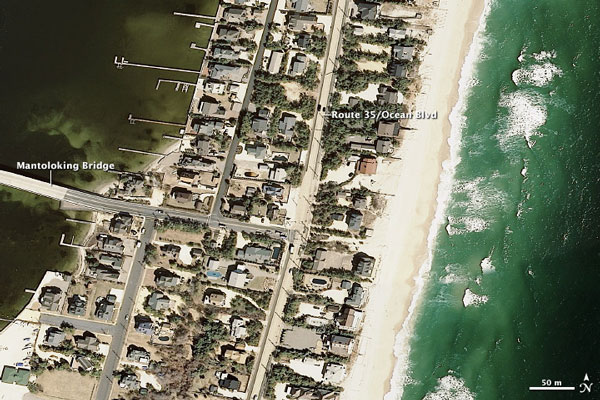Superstorm Sandy
Hurricane Sandy occurred from October 22nd-29th, 2012, and is also known as Superstorm Sandy. A typical hurricane is a large storm, lasting a week on average and can be learned more about by clicking here. However, Hurricane Sandy was also known as a Superstorm Sandy since it not only contained the normal energy of a hurricane generated from warm waters, but its collision into the Northeastern coast of the United States and their annual winter storm systems increased the storm’s size (The Making of a Superstorm). The storm not only caused damage through inundation, but widespread fires also occurred as a result (“Hurricane Sandy Fast Facts”).
The coastal geology and land subsidence of the barrier islands of New Jersey, which were severely hit by the storm, exaggerating the damages. Land subsidence, or the sinking of land, occurs in New Jersey due to groundwater pumping and urban development and can be learned more about by clicking here. This drainage, along with sea level rise from global climate change have created a recipe for high inundation levels in this coastal region. Figure 1 below exhibits the land subsidence in Atlantic City, New Jersey from 1981-1995. There exists a clear trend in an increase in subsidence and an increase in time, creating an overall decrease in the state’s height above sea level.

Figure. 1 Atlantic City land subsidence over time <http://users.rider.edu/~hsun/subsid.pdf>.

Figure 2. Atlantic Ocean sea level changes over time along the coast of New Jersey <http://users.rider.edu/~hsun/subsid.pdf>.

Figure. 3 Bathymetry elevation contours offshore of New Jersey <http://www.state.nj.us/dep/njgs/geodata/dgs06-1.htm>.
The cyclone formed and hit countries within the Caribbean such as Haiti and Cuba, where the most deaths occurred (54 deaths in Haiti and 11 deaths in Cuba). As it traveled north, it struck the eastern coast of the United States, and some parts of Eastern Canada (“Hurricane Sandy Fast Facts”).
Sand dunes existed on the coasts of the barrier islands to prevent major oceanic flooding, but they were completely destroyed after the superstorm, damaging more homes than anticipated (especially in Ortley Beach, Lavalette, and Mantoloking, NJ). Now, dunes and seawalls are being rebuilt to accommodate for a future storm.
In Mantoloking, NJ, the sea on the island’s east coast and the bay on the island’s west coast connected over land, forming a sea during the peak of the flood. This instance is unique since the town was hit by the storm from all sides, increasing its recovery time after the storm (Fig. 4 and Fig. 5).

Figure 4. Mantoloking before the superstorm with the Atlantic Ocean on the right and Mantoloking Bay on the left. <http://blogs.discovermagazine.com/80beats/2012/11/08/new-jersey-coast-before-and-after-sandy/#.V2LMvygrKM8>

Figure 5. The sea formed after the storm caused by the flooding of Mantoloking Bay and the Atlantic Ocean <http://blogs.discovermagazine.com/80beats/2012/11/08/new-jersey-coast-before-and-after-sandy/#.V2LMvygrKM8>
The storm killed more than 117 in the United States, and 69 in Canada and the Caribbean combined (The Making of a Superstorm). Many deaths occurred because the storm occurred during the winter and stripped buildings from access to heat, clean water, and electricity. Specifically, 7.5 million businesses and households experienced power outages in 15 states in the US along with the District of Columbia (“Superstorm Sandy Breaks Records”).
As a result, the superstorm is the second-costliest storm in the United States (second to Hurricane Katrina) at $68 billion (The Making of a Superstorm).
Additionally, since the storm hit during the presidential elections of 2012, affected residents were able to vote through fax and at any polling station nearest them (“Hurricane Sandy Fast Facts”), however this did not account for those who did not have fax machines in their homes or did not have transportation to areas with access to them.